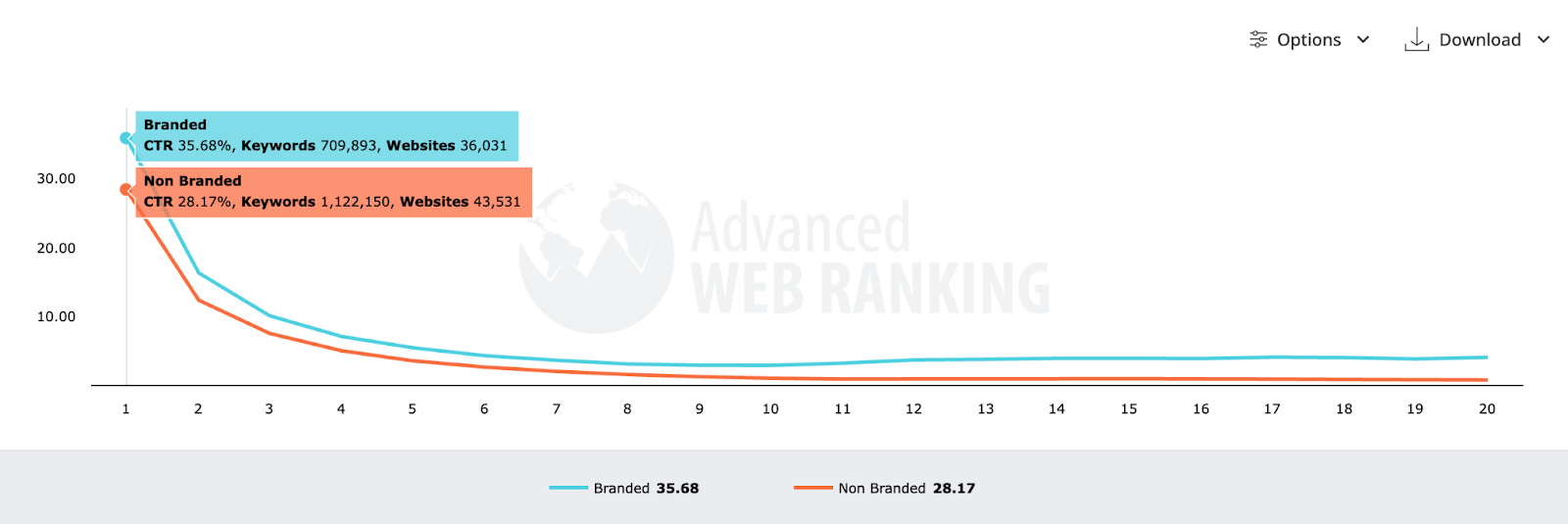
Why Branded Queries Matter Now More Than Ever
Published July 15, 2025
In 2025, branded queries drive higher CTRs, trust, and visibility in AI powered search. Learn why they matter more than ever & how to adapt your SEO strategy from Yordan Dimitrov.
The one consistent thing about SEO is that it’s always evolving. Since 2023, we’ve witnessed the rise of generative search with LLMs, followed by AI Overviews showing up in Google in 2024 and, most recently, the introduction of AI Mode in the US. SEOs are faced with multiple challenges: Strategies, metrics and budgets are shifting; and the term “The Great Decoupling” has emerged to describe the rise of impressions and drop in clicks that websites everywhere are experiencing.
The solution? Reinforcing brand building with organic search for long-term, sustainable results.
Branded keywords tend to perform well and offer a clear indicator of a website’s overall reputation and visibility. They act as a powerful marker when evaluating a brand’s presence and trustworthiness, particularly through the lens of E-E-A-T (Experience, Expertise, Authoritativeness, and Trust).
So let’s take a look at why and how to adapt your SEO strategy to focus more on branded queries.
Contents:
Your brand is more than a name & logo: it’s an asset or a threat to your visibility
Gianluca Fiorelli sums up the power of brand perfectly: “It's a distinctive identity that encompasses the unique values and reputation, designed to differentiate it and create a psychological and emotional bond with consumers.”
On average, according to Capital One Shopping Research, it takes consumers 5-7 exposures to remember a brand. And the mere-exposure effect illustrates that repeat exposure to a stimulus can lead to liking, even without conscious attention or deliberate cognitive processing.
So when users regularly see your brand name or content appear in search results, it becomes more familiar and trustworthy. This familiarity increases the likelihood of them clicking your listing even before reading the snippet, as people have the tendency to choose what feels familiar over an unknown competitor.
According to data from Advanced Web Ranking, branded queries capture significantly more clicks, on average 35.68% vs. 28.16% for non-branded queries at position 1 (internationally for all devices in May 2025.
The data demonstrates that branded search volume correlates more strongly with top organic rankings than domain authority, as search engines interpret user interest as a signal of relevance and trust. The familiarity and trust associated with a strong brand directly influence consumer behaviour, leading to higher click-through rates (CTRs), and indirectly impacting rankings.
This data shows a visible disparity, with branded keywords having significantly higher CTRs than non-branded keywords, especially in top positions.

Marketing principles & AI powered search
Building strong brand authority is also essential to adapting to AI search trends.
According to the AIDA Marketing framework by Elias St. Elmo Lewis there are four key stages of the user journey, namely Attention, Interest, Desire and Action.
AI Overviews & AI Mode primarily impact the Attention and Interest stages by providing prominent, summarised answers at the top of the search results. While they pose a challenge to traditional organic clicks by reducing the need for website visits, being cited within an AIO/AI Mode offers a new opportunity for visibility and establishing authority, which can indirectly influence the Desire stage. Their direct impact on the Action stage is less pronounced currently, especially for non-branded commercial queries, but this may evolve as Google continues to integrate AI into the search experience, potentially incorporating more action-oriented features within the AI interface itself.
Search intent, visibility and AI’s impact on SERP
As generative AI continues to evolve and embed itself into our search behaviour, it’s important to understand how different types of search intent are being impacted.
User journeys vary depending on the type of search intent(s) and recognising this is vital in the age of AI powered search. With the way information is presented on Google’s SERP, informational queries are increasingly being answered within AI Overview and often appearing on top of traditional organic listings. In this section, we will explore how this shift impacts visibility, CTR and what it means for SEOs and business owners.
According to data from Semrush, 88.1% of keywords that trigger an AI Overview target informational queries. What this means is that Google is actively summarising key information to help users find answers to their questions without leaving the Search Engine Results Page (SERP). This has been described as zero-click searches. As a result, between March 2024 and March 2025, zero-click searches increased from 23.6% to 26.10% across the UK and EU Market.
Google's mission is to “organise the world's information and make it universally accessible and useful”. In doing so, they provide users with an understanding of information from various sources directly on the SERP.
AI Overviews represent a major shift, often appearing at the very top of the SERP, consuming significant screen real estate. According to a report done by Botify and DemandSphere, they take up 42% of the screen on desktop and 48% on mobile, and when paired with Featured Snippets, they can command 67-76% of the screen above the fold. This dramatically reduces the visibility of traditional organic results, pushing even top-ranking content further down the page.
Google's continued development of AI Mode indicates a move towards a "conversational, personalised, AI-powered experience," as described by Gianluca Fiorelli, which will eventually replace the traditional search interface. This means that SEO is shifting from focusing purely on "position-based ranking" to achieving "semantic relevance + citation-level trust", where the goal is to be cited as a trusted source within AI-generated responses rather than simply ranking high in traditional "blue links".
Therefore, monitoring traffic that originates from these LLM platforms and understanding how users interact with them is crucial for adapting your content and SEO strategies effectively.
The importance of a human-centric approach
An important part of decision making is the Status Quo Bias, which is the human tendency to stick with what is known and has worked before. It's a deeply rooted decision-making practice stemming partly from psychological inclination. People also stick with what they know and what has worked in the past.
Google has been the dominant search engine for so long that its use is deeply ingrained in online habits. Its reputation and familiar interface contribute to it remaining the top choice for 8 in 10 respondents as per the SearchPulse data we, at Reflect Digital published in Q2 of 2025.
The phrase “Google It” has become a widely recognised, instinctive part of everyday language. What started as a noun evolved into a verb used to universally describe “look something up online”. This cultural transformation reflects the extent to which Google has anchored itself into our culture and user behaviour.
This kind of familiar behaviour shows that even as the search landscape evolves, people still interact with the biggest search engine out of habit and trust. While it’s important to monitor traffic from LLMs and adapt to AI powered search, it is just as important to understand the behavioural drivers behind why users engage with certain results, especially when it comes to brand.
When it comes to building your brand and digital presence online, you need to keep several behavioural factors in mind.
- Familiarity: Referencing back to the point I made earlier about mere exposure effect, the consistent exposure to your brand can increase the feelings of safety and trust among your audience. I highly recommend reading “Decoding the Mechanics of Brand Familiarity to Future-Proof Any Brand” by Giulia Panozzo and “Cognitive Insights for Local SEO: The “Pardon My French” Problem‘ by Myriam Jessier for a deeper dive into the topic.
- Brand Trust: Positive emotions linked to familiarity can positively impact perceived brand authority and trustworthiness. Brand trust and a positive reputation are crucial, fostering confidence and encouraging engagement. A consistent brand presence in search results builds familiarity and trust over time, leading to increased traffic and engagement.
- Brand Equity and User Engagement: Even with AI Overviews present, branded keywords that trigger AIOs can experience an increase in CTR. According to data from Amsive, Branded keywords that trigger AIOs actually experience an increase in CTR by +18.68% on average.
- Simplifying Search: When people search for brands with the intention to buy, it usually indicates they have narrowed down their options, making it easier to move forward with the purchase.
Choosing familiar brands spares cognitive resources and helps consumers when faced with too many choices (cognitive overload).
Adapting your SEO strategy
Adapting your SEO strategy to the new age of AI Overview, AI Mode and LLM powered search engines requires more than traditional keyword targeting.
You should avoid trend-chasing or producing content that does not align with your brand identity. Authenticity is key to your success. It does not only support brand recall, but also improves your credibility.
Segment your performance data to analyse the performance of your branded vs. non-branded traffic. Tools like Google Search Console allow you to use Regular Expression (RegEx) to filter branded queries or exclude them. You can also automate this process in Looker Studio using custom filters. This will help you measure your performance and make more informed decisions about your overall content strategy.
Monitor traffic that comes from LLMs, starting with ChatGPT, Gemini and Perplexity to understand how those users engage with your site. Semrush predicts that AI search traffic could overtake traditional search by 2028 or potentially sooner if the default Google Search experience becomes AI Mode.
Analysing performance across all channels, not just Organic, will ensure that you are on top of your overall performance and that you are focusing your efforts on the channel with the highest ROI. Having a holistic view will allow you to remain agile and reallocate resources as and when needed.
TL;DR conclusion
As the search landscape evolves, the distinction between brand and non-branded queries is no longer an optional metric to measure, it is an essential one. LLM powered search, trust signal and behavioural factors all suggest one direction: brands need to build recognition to outperform competitors still focused on a traditional keywords-based approach.
Through measuring the right metrics, analysing brand-specific performance and adapting your strategy continuously, you can protect and grow your visibility across LLMs and traditional search.

Yordan Dimitrov is an SEO Manager at Reflect Digital. He has spoken at various industry forums, including SEMantics, SEO Office Hours, SERP Conf. and Majestic’s SEO in 2025: Additional Insights, sharing practical insights on search trends, content, and technical SEO across sectors including e-commerce, leisure, and automotive.
Articles for every stage in your SEO journey. Jump on board.
Related Articles
 Speed-to-Meaning: Technical & Measurement Blueprint for AI Search
Speed-to-Meaning: Technical & Measurement Blueprint for AI Search
 How to Stay Relevant in a World of AI Overviews & Query-Fans
How to Stay Relevant in a World of AI Overviews & Query-Fans
 Plain-text Lifelines: How to Make Medical Content Visible in AI Search
Plain-text Lifelines: How to Make Medical Content Visible in AI Search
 Sitebulb Desktop
Sitebulb Desktop
Find, fix and communicate technical issues with easy visuals, in-depth insights, & prioritized recommendations across 300+ SEO issues.
- Ideal for SEO professionals, consultants & marketing agencies.
Try our fully featured 14 day trial. No credit card required.
Try Sitebulb for free Sitebulb Cloud
Sitebulb Cloud
Get all the capability of Sitebulb Desktop, accessible via your web browser. Crawl at scale without project, crawl credit, or machine limits.
- Perfect for collaboration, remote teams & extreme scale.
If you’re using another cloud crawler, you will definitely save money with Sitebulb.
Explore Sitebulb Cloud Yordan Dimitrov
Yordan Dimitrov


